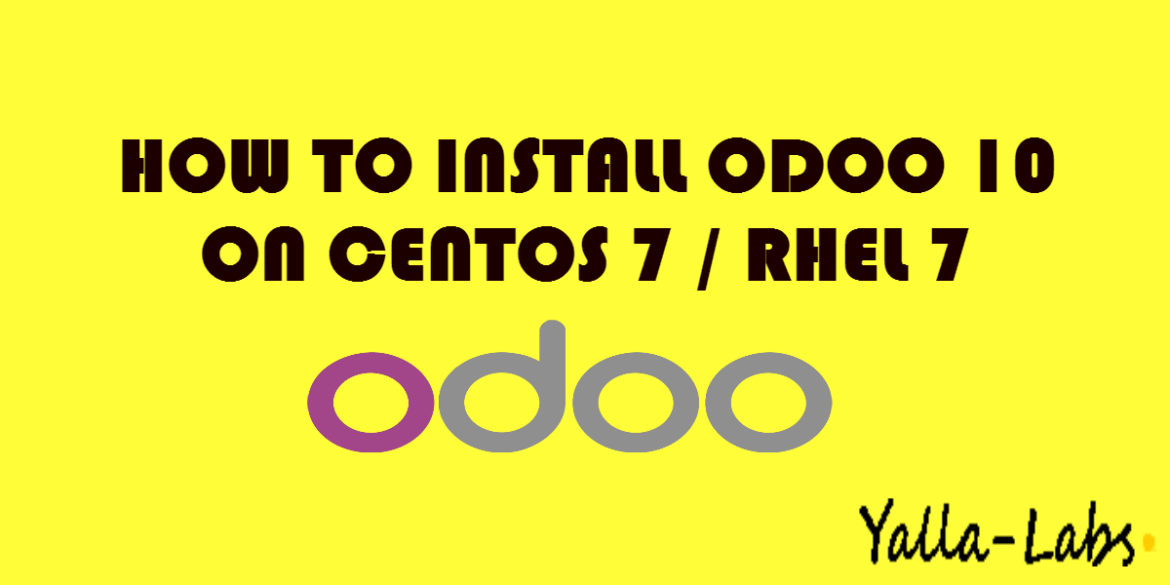Odoo, known as Open ERP and CRM , is a suite of open-source business apps written in Python and released under the AGPL license, that cover all the company needs: CRM, eCommerce, accounting, inventory, point of sale, project management, etc…
In this quick tutorial, we will cover how to install the latest Odoo 10 version on CenOS 7 / RHEL 7 server.
Step 1- Install Requirement packages
– Update the system
[root@odoo ~]# yum update -y
– Install EPEL Release Repository
[root@odoo ~]# yum install epel-release -y
– Install needed dependencies packages
[root@odoo ~]# yum install fontconfig libpng libX11 libXext libXrender xorg-x11-fonts-Type1 xorg-x11-fonts-75dpi wkhtmltopdf yum-utils -y
Step 2- Install and Configure PostgreSQL
– Install PostgreSQL
[root@odoo ~]# yum install postgresql-server -y
– Initialize PostgreSQL database
[root@odoo ~]# postgresql-setup initdb
– Enable/Start PostgreSQL
[root@odoo ~]# systemctl enable postgresql [root@odoo ~]# systemctl start postgresql
Step 3- Install Odoo 10
– Add the Odoo repository
[root@odoo ~]# yum-config-manager --add-repo=https://nightly.odoo.com/10.0/nightly/rpm/odoo.repo
– Install Odoo
[root@odoo ~]# yum install odoo -y
– Enable/ Start Odoo
[root@odoo ~]# systemctl enable odoo [root@odoo ~]# systemctl start odoo
– Configuration Odoo
The configuration file can be found at /etc/odoo/odoo.conf, open it and uncomment admin_passwd line and set a new master password
[root@odoo ~]# vi /etc/odoo/odoo.conf [options] ; This is the password that allows database operations: admin_passwd = your_new_admin_password . [root@odoo ~]# systemctl restart odoo
– Adjusting Firewall
[root@odoo ~]# firewall-cmd --zone=public --permanent --add-service=http [root@odoo ~]# firewall-cmd --zone=public --permanent --add-port=8069/tcp [root@odoo ~]# firewall-cmd --reload
Step 4- Access Odoo 10
– Open your favorite browser and navigate to http://yourdomain.com:8069 or http://server-ip:8069 and create your first database and start using Odoo 10 .
Thanks for watching, for additional help or useful information, we recommend you to check the official Odoo web site .
We hope this tutorial was enough Helpful. If you need more information, or have any questions, just comment below and we will be glad to assist you!
PS. If you like this post please share it with your friends on the social networks using the buttons below.Thanks.


10 comments
Not able to run this now.
Service Unavailable
The server is temporarily unable to service your request due to maintenance downtime or capacity problems. Please try again later.
Do you know why
Hi, make sure that you opened the port on the firewall and odoo can communicate with postgresql server
Try to disable Selinux temporarily using the following command setenforce 0 .
I followed this tutorial again and again on a clean digitalocean VPS 2GB. Not sure if the centOS distribution has problem. Is this installation for clean hosting?
Yes, I installed odoo in a clean server .Did you tried to disable selinux? And verify the port in the firewall ? Did you check if the port 8069 from outside is opened? Last check the logs
I’m running in aws machine with RHEL. I don’t have access to root user but I used following sentences:
“sudo yum install odoo -y ” I have received some errors. After that I have written:
“sudo systemctl enable odoo”
“sudo systemctl start odoo”
Both didn’t work.
Could you help me please.
Hi,
You can use any user with administrator privileges. Can you provide us the errors that you got .
I’m trying to install Oddo on my VPS,
“yum install odoo -y ” I have received some errors.
After that I have written:
“systemctl enable odoo”
“systemctl start odoo”
Both didn’t work. Please help me to check this.
Attach file: http://imageshack.com/a/img923/9712/a3UQLh.png
I think that u should install http_parser or you can skip the broken packages using the command :
# yum install odoo –skip-broken
if you are on Fedora and Fedora runs as VM, simply remove their default firewall built in with:
as root:
dnf remove firewalld
or
sudo dnf remove firewalld
Hi Andre,
Thx for the comment.